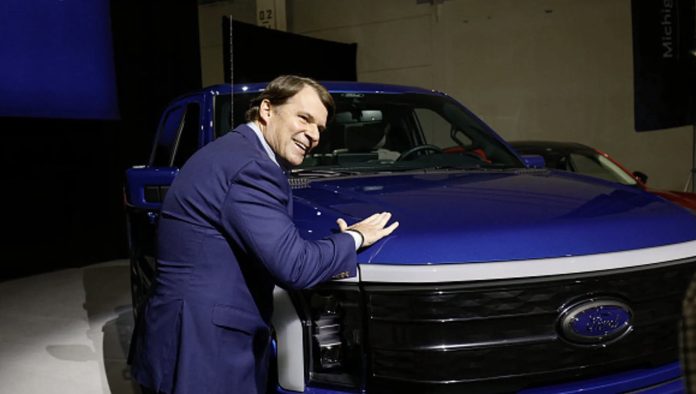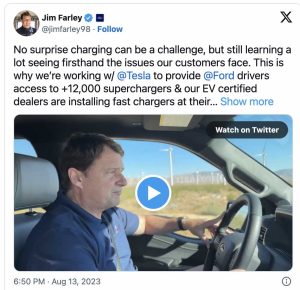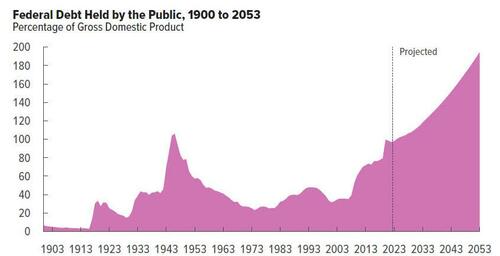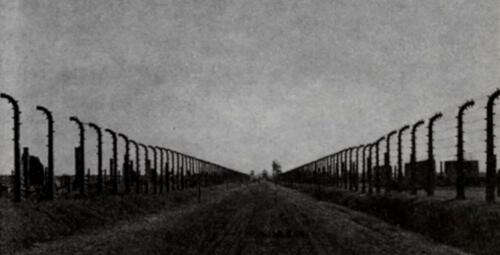This is a long and sometimes technical article. But to understand why we will have a reset sooner than later, it is a must read.
The 2008 crisis was a warning shot which could have gone very bad. Somehow the system survived another decade until we reached the end of the line in 2019. In this respect, the Covid crisis was not an accident but the opportunity to flood the system with large scale financing and literally "buy" another few years.
Authored by Alasdair Macleod via GoldMoney.com,
Globally, further falls in consumer price inflation are now unlikely
and there are yet further interest rate increases to come. Bond yields
are already on the rise, and a new phase of a banking crisis will be
triggered.
This article looks at the factors that have come together to drive interest rates higher, destabilising the entire global banking system.
The contraction of bank credit is in its early stages, and that alone
will push up interest costs for borrowers. We have an old fashioned
credit crunch on our hands.
A new bout of price
inflation, which more accurately is an acceleration of falling
purchasing power for currencies, also leads to higher interest rates. Savage bear markets in financial and property values are bound to ensue, driving foreign investors to repatriate their funds.
This
will unwind much of the $32 trillion of foreign investment in the fiat
dollar which has accumulated in the last fifty-two years. And BRICS’s deliberations for replacing the dollar as a trade settlement medium could not come at a worse time.

Global banking risks are increasing
Gradually,
the alarm bells over credit are beginning to ring. Monetarist and
Austrian School economists are hammering the point home about broad
money, which almost everywhere is contracting. It is overwhelmingly
comprised of deposits at the commercial banks. And this week, even
China’s command economy has had credit problems exposed, with another
large property developer, Country Garden Holdings missing bond payments.
A
global cyclical downturn in bank credit is long overdue, and that is
what we currently face. Empirical evidence of previous cycles,
particularly 1929—1932, is that fear can spread though the banking
cohort like wildfire as interbank credit lines are cut, loans are called
in, and collateral liquidated. The question arising today is whether
the current credit cycle downturn is more acute than any of those faced
by our fiat currency world since the 1970s, or whether timely expansions
of central bank liabilities can come to the rescue again.
The
problem with using monetary policy to avert a financial crisis is that
there is bound to come a time when it fails, particularly when it is
driven by bureaucrats whose starting point is an assumption that banks
are adequately capitalised for an economic downturn. This ignores
unproductive debts from previous cycles which have simply accumulated
into a potential tsunami of defaults. When it overwhelms the banks, the
policy response can only be so destructive of the currency that the cure
exacerbates the problem. And with bond yields rising again, there are
good reasons to believe that a tipping point is now upon us.
Credit,
which is synonymous with the towering mountains of debt is all about
faith: faith in monetary policy, faith in the currency, and faith in a
counterparty’s ability to deliver. Before we look at risks faced by the
fiat currency cohort, it is worth listing some of the factors that can
lead to the collapse of a credit system:
Contracting bank credit.
Contracting bank credit is the consequence of the bankers recognising
that lending risks are escalating. It is an acute problem when bank
balance sheet leverage is high, magnifying the potential wipe-out of
shareholders’ capital arising from bad and doubtful debts. Consequently,
both normal and overindebted borrowers whose cash flow has been hit by
higher interest rates are denied loan facilities, or at the least they
are rationed at a higher interest cost. Therefore, the early stages of a
credit downturn see interest rates rising even further leading to
business failures. Essentially, the central banks lose control over
interest rates.
Interbank counterparty risks. There
is a long history of banks suspecting that one or more of their number
has become overextended or mismanaged and is therefore a counterparty
risk. Banks have analytical models in common to determine these risks,
so there is a danger that the majority of banks will share the same
opinion on a particular bank at the same time, leading to it being shut
out of wholesale markets. When that happens, it cannot fund deposit
outflows, is forced to turn to the central bank for support, or it
suddenly collapses. Recently, this was the fate of Silicon Valley Bank. A
downgrade by a credit agency, such as S&P or Fitch, could trigger
an interbank lending crisis, either at a local or international level in
the case of a country downgrade. These downgrades have now started.
Rising bond yields. Banks
usually stock up on government debt, redeploying their assets when they
are cautious about lending to the private sector. Therefore, an
increase in bond holdings tends to be countercyclical with reference to
the credit cycle, with exposure limited to maturities of only a year or
two. This pattern has been broken by central banks suppressing interest
rates to or below the zero bound at a time of prolonged economic
stagnation. Again, Silicon Valley Bank serves as an example of how this
can go horribly wrong. It was able to fund bond purchases at close to
zero per cent to buy Treasury and agency debt of longer maturities to
enhance the credit spread. When interest rates began to rise, the bank’s
profit and loss account took a hit, and at the same time, the market
values of their bond investments fell substantially, wiping out its
balance sheet equity. The Fed has taken on this risk by creating the
Bank Term Funding Programme, whereby the Fed takes in Treasuries at
their redemption value in return for cash in a one-year swap.
Essentially, the problem in the US is covered up and accumulating on the
Fed’s balance sheet instead — though this is not reflected in the Fed’s
accounting practices. The draw-down in this facility is currently $107
billion and rising.
Quantitative tightening. Collectively,
the major central banks (the Fed, ECB, BoJ, and PBOC) have reduced
their balance sheets by some $5 trillion since early-2022. This QT has
been put into effect by not reinvesting the proceeds of maturing
government debt. Nearly all of the reduction in the central banks’
balance sheets is reflected in commercial bank reserves, which are
balances recorded in their accounts as assets. Accordingly, the
commercial banking system as a whole comes under pressure to reinvest
the released reserves into something else, or to reduce its combined
liabilities to depositors, bondholders, and shareholders. Initially, the
commercial banking system can only respond by increasing holdings of
three and six months treasury bills, which is an unstable basis for
government funding.
Collateral liquidation. All
the charts of national bond yields scream at us that they are
continuing to rise, instead of stabilising and eventually going lower as
the majority of market participants appear to beleive. Furthermore,
with oil and other energy prices now rising strongly, the prospect of
yet higher interest rates driven by contracting bank credit (as detailed
above) along with a number of other factors discussed in this article
point to significantly higher bond yields driving a bear market in
financial assets and property values. Where banks hold collateral
against loans, there will be increasing pressure on them to sell down
financial assets before their values fall further.
Property liabilities. Bank
lending for residential and commercial property will have to absorb
substantial write-offs from the consequences of interest rates driven
higher by price inflation and contracting bank credit. The Lehman crisis
was about lending and securitisation of mortgage debt. This time,
higher interest rates will add commercial real estate into the equation.
Shadow banks. Shadow
banks are defined as institutions which recycle credit rather than
create it for which a banking licence is required. It includes pension
funds, insurance companies, brokers, investment management companies,
and any other financial entity which lends and borrows stock or deals in
derivatives and securities. All these entities present counterparty
risks to banks and other shadow banks. Some of the risks can emerge from
unexpected quarters, as was illustrated by the pension fund blow-up in
the UK last September.
Derivatives. Derivative
liabilities come from global regulated markets, which are assessed by
the Bank for International Settlements to have an open interest of about
$38 trillion last March with a further $60 trillion notional exposure
in options. Markets in unregulated over-the-counter derivatives are far
larger, at an estimated $625 trillion at end-2022 comprised of foreign
exchange contracts ($107.6 trillion) interest rate contracts ($491
trillion) equity linked ($7 trillion), commodities ($2.3 trillion), and
credit including default swaps ($9.94). All derivatives have chains of
counterparty risk. We saw how a simple position in US Treasuries
undermined Silicon Valley Bank: a failure in the derivative markets
would have far wider consequences, particularly with regulators being
unaware of the true risk position in OTC derivatives because they are
not in their regulatory brief.
Repo markets. In
all banking systems, some more than others, banks depend on repurchase
agreements to ensure their liquidity. Low interest rates and the
availability of required collateral feature in this form of funding.
Particularly in Europe, repo quantities outstanding have built up in
various currencies to over €10.4 trillion equivalent according to the
International Capital Markets Association. Essentially, these amounts
represent imbalances within the financial system, which being
collateralised have become far larger than the traditional overnight
imbalances settled in interbank markets. Even though repos are
collateralised, the consequences of a counterparty failure are likely to
be far more concerning to the stability of the banking sector as a
whole. And with higher interest rates, a bear market in collateral
values seems set to dry up this liquidity pool.
Central bank balance sheets. Central
banks which have implemented QE have done so in conjunction with
interest rate suppression. The subsequent rise in interest rates has led
to substantial mark to market losses, wiping out their equity many
times over when realistically accounted for. Central banks claim that
this is not relevant because they intend to hold their investments to
maturity. However, in any rescue of commercial banks, their technical
bankruptcy could become an impediment, undermining confidence in their
currencies.
Looking at all these potential areas for
systemic failure, it is remarkable that the sharp rise in interest rates
so far has not triggered a wider banking crisis. The failures of Credit
Suisse and a few regional banks in the US are probably just a warm-up
before the main event. But when that time arrives, it becomes an open
question as to whether central banks and their governments’ treasury
ministries will pursue bail-in procedures mandated in G20 members’ laws
in a knee-jerk response to the Lehman crisis. Or will they resort to
bailouts as demanded by practicalities? Lack of coordination on this
issue between G20 nations could jeopardise all banking rescue attempts.
Additionally,
while technicians in central banks have some understanding of credit
and the practicalities of banking, the same cannot be claimed of bank
regulators. They rarely have hands-on experience of commercial banking.
They devise stress tests, the starting assumption of which is that banks
regulated by them will survive. Otherwise, they will be demonstrated to
have failed in their duties as regulators. It is noticeable how the
economic assumptions behind prospective banking stresses are almost
always unrealistically mild.
When the muck hits the fan, the
bureaucratic imperative is to deflect all blame of the failure to the
commercial banks themselves, away from their own incompetence.
The US banking system’s weak points
As
the reserve currency for the entire global fiat currency system, the
dollar and all bank credit based upon it is likely to be the epicentre
of a global banking crisis. If other currencies weaken or fail, there is
likely to be a temporary capital flight towards the dollar before
financial contagion takes over. But if the dollar fails first, all the
rest fail as well.
The condition of the US banking system is
therefore fundamental to the global economy. There are now signs that
not only is US bank credit no longer growing but is contracting as well.

The
chart above is the sum of all commercial bank deposits plus reverse
repurchase agreements at the Fed. While the latter are technically not
in public circulation, they have been an alternative form of deposits
for large money market funds that otherwise would be reflected in bank
deposits. Recently, having soared from nothing when the Fed permitted
certain non-banks to open repo accounts with it in 2021, to a high of
$2,334.3 billion last September, the facility has subsequently declined
by $543 billion. Adding this change into the bank deposits figures shows
the true contraction of bank credit to be $1,203 billion, which is 5.9%
of the high point earlier this year. Some of the difference in bank
liabilities has been taken up by an increase in loans to commercial
banks ($556 billion) which is understandable when depositors earn
virtually nothing on their deposits compared with fixed loans to a
bank.
When these factors are considered, total assets are not yet
significantly below their peak, indicating that so far banks have been
only rearranging their assets with a view to controlling risk.
Therefore, the credit crisis it is still in its early stages, which the
potential to increase significantly.
The chart below indicates why in a deteriorating lending environment banks are sure to contract their balance sheet totals.
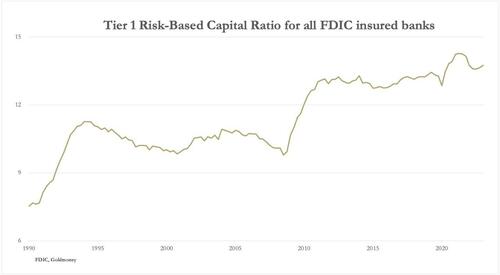
Over
the last three decades, the ratio of total assets to tier 1 risk
capital has grown from just under eight times, which historically was
considered as normal, to a recent fourteen times. It is this leverage
ratio that threatens to wipe out shareholders’ capital if the combined
level of non-performing loans and mark-to-market write-offs on financial
investments increases from here.
A second weak point is the US’s
dependency on foreign dollar short-term holdings including bank
deposits, which according to the US Treasury totalled $7,122 billion
last May. Of that total, $2,367 billion are bank deposits, being 13% of
the total in the US banking system. But to the total of short-term
holdings must be added long-term holdings of $24,788 billion for a grand
total of short and long-term investments of almost $32 trillion. This
is substantially in excess of US GDP and has accumulated as a result of
two related factors. Since the Bretton Woods Agreement in 1944, the
dollar has been the reserve currency, and internationally commodity
prices have always been quoted and dealt in with dollars.
Within
living memory, accumulation of dollars in foreign hands became excessive
once before. It led to dollars being redeemed for gold, reducing US
gold reserves from 21,682 tonnes in 1948 to 9,070 tonnes in 1971, when
the run on gold led President Nixon to suspend the Bretton Woods
Agreement. Following the abandonment of Bretton Woods, to date the
dollar has lost 98% of its purchasing power measured in real, legal,
international money which is gold. Due to its reserve currency status
and persistent US trade deficits, the proportion of foreign ownership of
dollars to US GDP has continued to grow. But recent geopolitical events
are threatening to reverse that trend.
As dollar bond yields
rise, undermining the capital values of the $32 trillion of
foreign-owned financial assets and bank deposits, foreigners are bound
to sell their dollar assets to avoid mounting losses. And already, we
see many foreign nations which are not allied with America beginning to
take evasive action. It is rumoured that next week there will be up to
60 nations attending the BRICS summit in Johannesburg, all seeking an
alternative to the dollar’s hegemony. Russian state media has clearly
stated that a new gold-backed trade settlement currency is on the
summit’s agenda, calling an end to the dollar’s fiat currency regime.
Whatever
comes out of the summit, it is clear that the fiat dollar regime has
almost run its course. The withdrawal of credit from the US economy will
undermine the currency, increase the rates of US producer and consumer
price inflation, and therefore drive up bond yields. Financial asset and
property values which have become dependent on cheap finance will take a
massive hit, serving to encourage additional foreign selling of
non-financial assets. The losses for banks, not just in the US, are set
to rapidly escalate.
Undoubtedly, banks will come under pressure
to bail out the US Government from a further deterioration of its
finances at a time when foreigners are more interested in selling US
Treasuries than buying them. To an extent, substituting dodgy loans to
the private sector for government debt is attractive to the banks, but
only with very short-term maturities. The consequence will be that
government financing of maturing Treasuries and of new issues will be
facilitated by 3-month and 6-month T-bills, which can be regarded as
near-cash. The inflationary consequences are one thing, but the impact
of rising interest rates due to the dollar being sold down by foreign
agents will intensify the debt trap by rapidly increasing debt funding
costs.
As if this is not enough, at the same time the collapse of
bank credit is bound to act negatively on derivative obligations. The
table below is a snapshot of OTC obligations for the top twelve US
banks.[i]

For
the reader losing count of all the noughts, it should be noted that for
the top nine their exposure is in the trillions. While it is true that
some OTC derivatives, such as credit and credit default swaps are not
obligations for their notional amounts, others such as foreign exchange
derivatives, commodity, and equity-linked contracts ($117 trillion) are
extinguished for the full amount. But they are only recorded on bank
balance sheets as insignificant contract values.
For example, in
the BIS derivative estimates quoted earlier in this article, the
notional value of foreign exchange OTC contracts last December was
$107.576 trillion with a gross market value of $4.846 trillion. It is
the latter figure which is the basis recorded in bank balance sheets.
But even that total is further reduced by being listed as a net balance
of purchase and sold obligations, reducing apparent exposure to an even
smaller figure. Essentially, over $107 trillion of assets and
liabilities are made to disappear.
According to the BIS’s 2022
triennial OTC derivatives survey, the US dollar is a component of 88.5%
of this FX position. Other than offshore trading between non-US banks in
Eurodollars, which is a minor proportion of the total, all dollar
contracts have US banks as counterparties. This gives rise to two
systemic threats. The first and most obvious is counterparty failure
with a foreign bank or shadow bank. Obviously, with rising interest
rates and collapsing financial asset values in collateral, the risk of
counterparty failure from outside the US banking system will increase.
The second counterparty failure comes from contracts between two US
banks or shadow banks.
We can be sure that central bankers (if not
bank regulators) are fully aware of these risks, refusing to draw
public attention to them. For confirmation, we saw the Fed rescue AIG in
September 2008 in an $85 billion bailout. AIG was the world’s largest
insurance company at that time, and an originator of credit default
swaps and other derivative obligations. There were other factors
involved, such as securities lending. But clearly, for the Fed to rescue
an insurance company must have reflected the Fed’s concerns about AIG’s
failure as a counterparty in the CDS market.
The new BRICS gold currency
Next
week, we will know more about the proposal being presented at the BRICS
summit in Johannesburg. All the indications are that this new
settlement currency will be denominated in a quantity of gold, such as
gold grammes. The return of gold backed credit is an important
development for the growing BRICS family and all the member nations,
dialog partners and associates of the Shanghai Cooperation Organisation
seeking a better alternative to the US dollar. Furthermore, it is now in
Russia’s strong interest to undermine the US dollar, lifting oil and
gas dollar prices to stabilise a falling rouble.
The extent to
which the plan for a new gold denominated currency is credible seems set
to undermine the dollar’s value expressed in commodities, goods, and
services externally in addition to the domestic economic and monetary
factors mentioned above. The foreign exchanges will begin to anticipate
that dollar reserves held by central banks in the growing BRICS camp
will become increasingly redundant, to be replaced with the new gold
trade settlement currency. Sovereign wealth funds are bound to follow by
reducing their dollar balances, as will international commodity dealers
and importers.
Not only will dollars be sold, but the need to
recycle them into US Treasuries and other investments will fall away.
Unless the US Government acts to radically cut its borrowing
requirements, it will face a rapidly deteriorating funding situation.
The dollar costs of commodities, raw materials and imported goods will
rise due to the dollar’s weakness. Consequently, dollar interest rates
are bound to rise to reflect the premium foreign holders will demand to
retain their dollar balances. And even that is unlikely to be enough.
The great unwind of the last fifty-two years of pure fiat dollars will
surely threaten not only the dollar’s existence, but its highly
leveraged banking system.
The discarding of the fiat currency past
for a currency or currencies more closely allied to energy and
commodities, which is actually what gold represents, is not limited to
the destruction of fiat dollars, but of all other fiat currencies as
well. For our current purposes, what also concerns us is the same threat
faced by the other major currencies: the euro, yen, and sterling.
It
has already been mentioned that an initial failure in the US banking
system will be the likely course of events because it is the most
over-owned of all the major fiat currencies. But if a banking crisis
does break out elsewhere first, it could lead to the dollar being
temporarily bought as a safe haven until financial contagion undermines
all banking relationships. It behoves us to look at the position in
these other major currencies. And the example we will take is of the
issues which face banks in the Eurozone.
The euro system
In
common with other major central banks, the ECB and its network of
national central banks, together the euro system, have accumulated
government and other bonds through quantitative easing. The extent to
which it has boosted the size of the euro system balance sheet and
subsequently declined is shown in the chart below.

Having
hit a high point of €8,828 billion fifteen months ago, the ECB’s and
national central banks’ combined assets have declined to €7,167 billion.
Most of the increase from the last financial crisis to the peak had
been through what the ECB calls asset purchase programmes, but otherwise
known to us as quantitative easing. The decline in total assets has
been achieved by allowing short-term assets to mature and for the funds
to be not reinvested, leading to the liabilities to commercial banks
being reduced.
Nevertheless, on the remaining securities holdings
totalling €4,865 billion currently, there are significant losses on a
mark-to-market basis. Assuming an average maturity of five years, and an
average rise in yield from 0% to 3.2% on Eurozone government bonds,
over the last year the losses in the euro system amount to about €700
billion. This is nearly six times the combined euro system’s equity. The
valuation problem is concealed by euro system accounting, which values
bonds on a straight line basis between purchase price and final
redemption value.
To assume that this is not a problem because the
ECB can always print euros is complacent. The only hope for the
Eurosystem is for bond yields to decline, and therefore values to rise
restoring balance sheet integrity. But for now, yields are rising, and
it is becoming clear that they will continue to rise. At some stage, the
assumption that inflation will return to target and that interest rates
and bond yields will decline will be abandoned, and the
recapitalisation of the entire euro system will then have to be
contemplated.
It will not be easy. Undoubtedly, legislation at a
national level in multiple jurisdictions will be required. It is one
thing for the ECB to railroad its inflationary policies through despite
protests from politicians in Germany and elsewhere, but begging for
equity capital puts the ECB on the back foot. Questions are bound to be
raised in political circles about monetary policy failures, and why the
TARGET2 imbalances exist. The whole recapitalisation process could
descend into a very public dispute, particularly since national central
banks may need capital injections as well before they can recapitalise
the ECB in proportion to their shareholder keys.
Yet, Europeans
rely upon the euro system to backstop the entire commercial banking
network, whose global systemically important banks (GSIBs) are even more
leveraged than the American banks. Furthermore, there are bound to be
hidden Eurozone equivalents of Silicon Valley Bank, whose balance sheets
have been undermined to the point of insolvency by the unexpected rise
in interest rates and the collapse in bond values. The €10 trillion repo
market also faces collapsing collateral values. Eurozone GSIBs have
heavy exposure to derivative counterparty risks. Yet, the euro system
itself is bankrupt, having paid top euros for bonds which have been
sinking faster than a tropical sun at twilight.
It is in the
nature of a banking crisis that several factors come together in an
unexpected perfect storm. We will all be wise after the event. But for
now, we can only observe the disparate strands likely to come together
and destroy the euro system, its commercial banks, and possibly the euro
itself.
That is, if the US banking system doesn’t collapse first.






